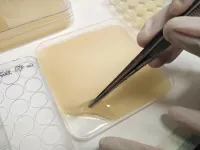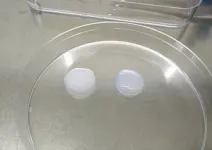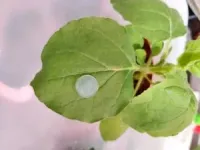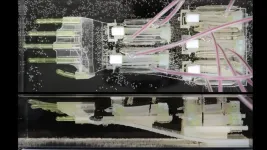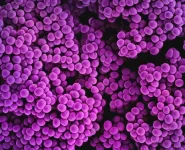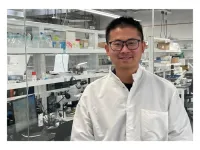Information embargoed until February 12, 2025 at 20:00h (time in Spain)
Bacterial cellulose promotes plant tissue regeneration
Researchers have successfully uncovered the molecular mechanisms by which bacterial cellulose patches stimulate the regeneration of plant wounds.
The regeneration process requires the activation of both hormonal and defense response pathways simultaneously.
These cellulose patches offer potential applications in grafting, pruning, and ornamental flower cutting for enhanced plant healing.
Bellaterra (Barcelona), February 12, 2025
A groundbreaking study, co-led by researchers from the Center for Plant Biotechnology and Genomics (CBGP) and Centre for Research in Agricultural Genomics (CRAG), has elucidated the mechanism by which bacterial cellulose mediates plant tissue regeneration. The work has been published today in the prestigious journal Science Advances and includes collaborations with researchers of the Institute of Materials Science of Barcelona (ICMAB-CSIC) and Colorado State University.
Bacterial cellulose (BC), synthesized by certain bacteria as a biofilm, consists of highly pure cellulose fibers. BC has been widely used in human biomedical applications showing a high degree of biocompatibility, but its potential healing effects in plants were unknown.
In this work, scientists have demonstrated that BC patches induce plant tissue regeneration and have identified for the first time the precise molecular mechanism underlying the process. Wounded leaves of the model plants Nicotiana benthamiana and Arabidopsis thaliana were covered with BC patches and formation of new cells on both sides of the cut was observed two days post-wounding, reaching complete wound closure after seven days. This wound healing process was promoted by BC but not by other structurally similar matrixes such as plant cellulose, indicating that BC had specific features beyond preventing dehydration or promoting physical contact.
Scientists discovered that BC patches contain cytokinines, a class of hormones involved in plant development. “Plants with defective cytokinin signaling did not respond to BC patches, confirming that cytokinines are crucial for triggering regeneration”, explains Nerea Ruiz-Solaní, a co-first author of the study.
The team also identified production of oxidative stress (ROS) at the wound sites upon BC application. Genomic and bioinformatic analyses enabled scientists to identify the specific genes involved in the process, which are typically associated with biotic responses, i.e. defense mechanisms against pathogens. The transcription factor WRKY8, which regulates defense responses, was found to interact directly with the promoter of GSTF7 gene leading to ROS accumulation.
Importantly, it is the concurrent activation of both the cytokinin and defense signaling pathways that results in the observed tissue regeneration, a novel finding since these mechanisms were previously studied independently. Further research would be needed to fully elucidate the pathways leading to cell cycle activation and functional differentiation during regeneration.
“Bacterial cellulose triggers a unique transcriptional program that differs from typical wounding-and callus-induced regeneration”, states Miguel Moreno-Risueño, co-leader of the study and an expert in plant regeneration at the CBGP.
This research holds significant implications for agricultural practices, including wound healing to prevent infections, and applications in grafting, pruning, and ornamental plant care, particularly in vineyards, rose cultivation, and stone pine production. This work started a few years ago, back in 2016, with joint projects between CRAG and ICMAB-CSIC research groups led by Núria Sánchez Coll and Anna Laromaine, respectively, and in collaboration with companies such as AGROMILLORA and Forestal Catalana S.A. (Plant Healing and Plant Nanohealing projects), which conducted preliminary field trials. However, further field studies are still needed to confirm the efficacy of BC patches in grafting. More technology transfer resources are needed to bridge the gap between fundamental research and the productive sector, with significant economic implications.
Núria Sanchez Coll, CSIC researcher at CRAG and co-leading author, highlights the collaborative nature of this research: “This work has fostered very interesting collaborations with other research groups as well as industry, paving the way for further studies on plant regeneration mechanisms and potential biotechnological applications."
________________________________________
Reference Article: Nerea Ruiz-Solaní† , Alejandro Alonso-Díaz† , Montserrat Capellades, Laura Serrano-Ron, Miquel Ferro-Costa, Álvaro Sanchez-Corrionero, Agnese Rabissi, Cristiana T. Argueso, Ignacio Rubio-Somoza, Anna Laromaine, Miguel A. Moreno-Risueno*, Núria S. Coll*. Exogenous bacterial cellulose induces plant tissue regeneration through the regulation of cytokinin and defense networks. Science Advances, 2025 https://doi.org/10.1126/sciadv.adr1509
About the authors and funding of the study: Research was supported by grants PID2022-136922NB-I00 funded by MICIU/AEI/ 1072 10.13039/501100011033 and by “ERDF/EU”; PID2019-108595RB-I00 funded by MICIU/AEI/ 1073 10.13039/501100011033; and AGL2016-78002-R funded by MICIU/AEI/ 1074 10.13039/501100011033 and by “ERDF A way of making Europe” to N.S.C.. Grants PID2022- 1075 140719NB-I00 funded by MICIU/AEI/ 10.13039/501100011033 and by “ERDF/EU” and 1076 PID2019-111523GB-I00 funded by MICIU/AEI/ 10.13039/501100011033 to M.A.M.-R.. Grants 1077 RTI2018-097262-B-I00 to I.R.-S. and MAT2015-64442-R to both A.L. and N.S.C funded by 1078 MICIU/AEI/ 10.13039/501100011033 and by “ERDF A way of making Europe”; grant TED2021- 1079 131457B-I00 to N.S.C. funded by MICIU/AEI/10.13039/501100011033 and by the “European 1080 Union NextGenerationEU/PRTR” and grant 2016 LLAVOR 00052 to A.L., N.S.C. and A.R. 1081 funded by Secretaria d'Universitats i Recerca de la Generalitat de Catalunya and ERDF. This Science Advances Manuscript Template Page 42 of 46 1082 research was also funded by Severo Ochoa Program for Centres of Excellence in R&D’, grants 1083 (SEV-2015-0533 and CEX2019-000902-S) to N.S.C. through CRAG, (SEV-2015-0496) to A.L. 1084 through ICMAB and (SEV-2016-0672 2017-2021 and CEX2020-000999-S) to M.A.M.-R. through 1085 CBGP funded by MICIU/AEI/ 10.13039/501100011033. N.S.C. and M.M.-R. carried out part of 1086 this work as recipients of the grants “Estancias de personal docente y/o investigador senior en 1087 centros extranjeros 2022” (PRX22-00348 and PRX22/00429, respectively) sponsored by the 1088 Fulbright Program and the Ministerio de Universidades (MUNI). This work was also supported by 1089 a grant from the National Science Foundation (MCB-1818211) to C.T.A. N.R.-S. was funded by 1090 contract FPU19/03778 from Ministerio de Universidades (MUNI), and A.A.-D., L.S.R and A.S.C 1091 by contracts BES-2014-070444, BES-2017-080155 and BES-2014-068852, respectively, funded 1092 by MICIU/AEI/10.13039/501100011033 and by “ESF Investing in your future”.
About the Centre for Research in Agricultural Genomics (CRAG): CRAG is a centre that forms part of the CERCA system of research centres of the Government of Catalonia (Spain), and which was established as a partnership of four institutions: the Spanish National Research Council (CSIC), the Institute for Agri-Food Research and Technology (IRTA), the Autonomous University of Barcelona (UAB) and the University of Barcelona (UB). CRAG’s research spans from basic research in plant and farm animal molecular biology, to applications of molecular approaches for breeding of species important for agriculture and food production in close collaboration with industry. In 2020, CRAG was recognized for the second time as a "Severo Ochoa Centre of Excellence” by the Spanish Ministry of Science, Innovation and Universities.
About the Center for Plant Biotechnology and Genomics (CBGP): The mission of CBGP (UPM-INIA/CSIC) is to conduct fundamental and strategic research in plant biology and microorganisms that interact with plants. The studies conducted by the various groups at the Center aim to understand, from a multidisciplinary perspective, essential processes such as plant development, plant interaction with the environment, and the molecular mechanisms that regulate plant nutrition. Additionally, CBGP (UPM-INIA/CSIC) develops new tools in computational biology and genomics and develops and applies synthetic biology tools to achieve these objectives. Acquiring basic biological knowledge is essential to tackle the challenges faced by agricultural and forestry production and contribute to the development of new biotechnological solutions. CBGP (UPM-INIA/CSIC) also plays a significant role as an educational institution, serving as a reference center for the training of young scientists, as well as master’s and bachelor’s degree students in the areas of Plant Biotechnology and Genomics. CBGP is a Severo Ochoa Center of Excellence and has received this excellence seal from the Ministry of Science and Innovation twice (2017-2021 and 2022-2025).
About the Institute of Materials Science of Barcelona (ICMAB-CSIC): The ICMAB-CSIC is a multidisciplinary research center that belongs to the Spanish National Research Council (CSIC). It is an institution dedicated to cutting-edge research on advanced functional materials in the fields of energy, electronics, nanomedicine, and emerging applications in these areas. In 2024, the ICMAB received the Severo Ochoa Center of Excellence accreditation from the Ministry of Science, Innovation, and Universities for the third consecutive time since 2016.
Materials:
1_BC-film.jpg: BC film grown in a square Petri dish (Credit: CRAG)
2_BC-patches.jpg: Two round BC patches in a Petri dish (Credit: CRAG)
3_BC-Nicotiana.jpg: BC patch on a Nicotiana benthamiana leaf (Credit: CRAG)
4_Regeneration-Nicotiana.png: Regeneration of a cut in a Nicotiana benthamiana leaf 7 days after BC application (arrow) compared to the control (arrow head) (Credit: CRAG)
5_BC short clips.mp4: Short videos of CRAG researchers working with BC (Credit: CRAG)
6_Infographic_ENG.jpg: Schematic summary of the main findings of the study (Credit: CRAG)
Materials can be dowloaded here: https://tuit.cat/lzruw
For more information and interviews:
Muriel Arimon
Communication Department
Centre for Research in Agricultural Genomics (CRAG)
+34 93 563 66 00 Ext 3033
+34 600 008 159
email: muriel.arimon@cragenomica.es
END
